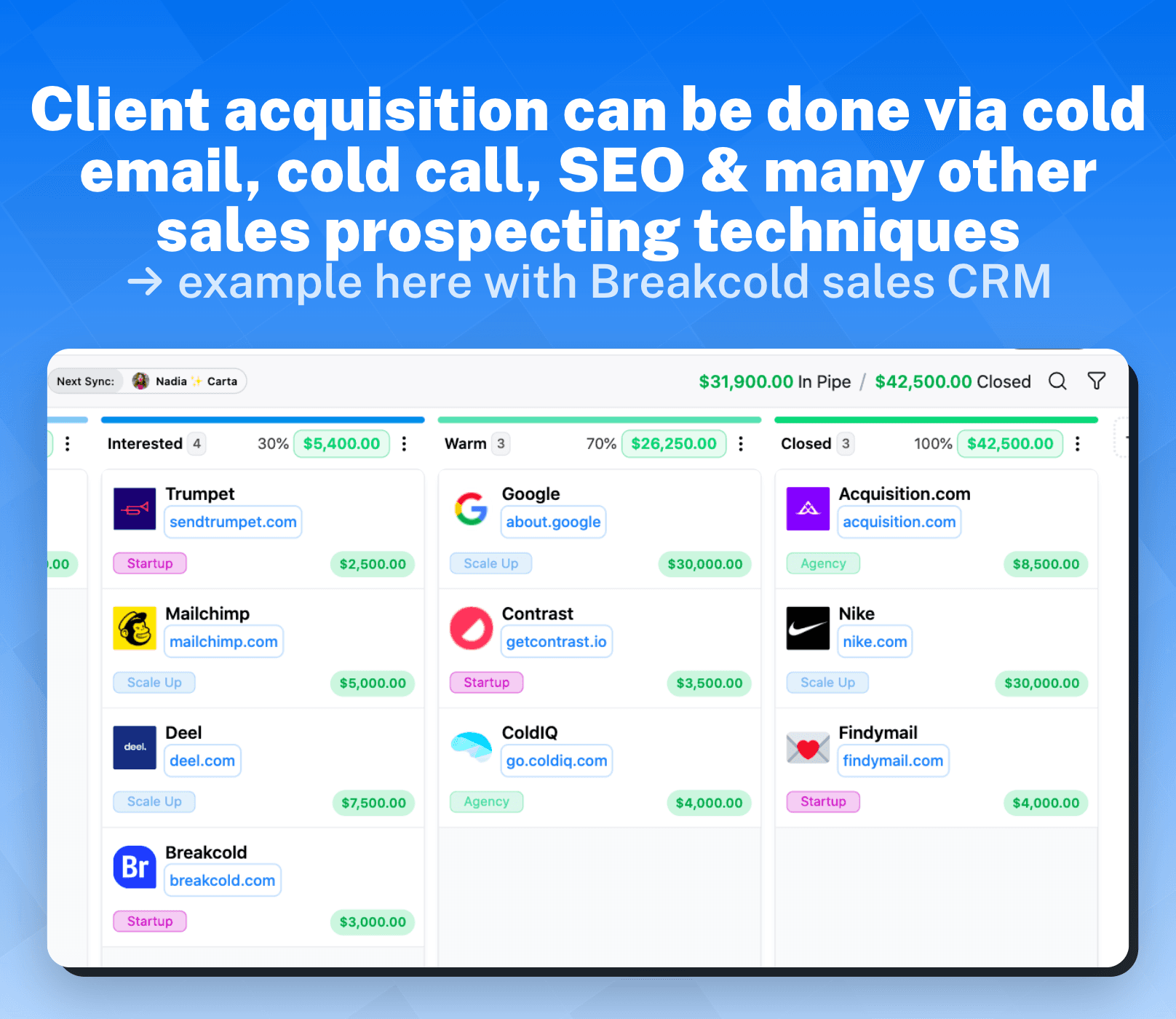
What is Client Acquisition? (Explained With Examples)
Client acquisition refers to the process of attracting and converting new customers or clients for a business. It is an essential aspect of any business strategy as it directly impacts revenue and growth. In this article, we will delve deeper into the concept of client acquisition, its definition, advantages, disadvantages, and provide examples in different contexts to help you understand its importance
1°) What is Client Acquisition?

Client acquisition encompasses all the activities and strategies that businesses employ to acquire new clients. It starts with identifying potential customers, engaging with them, convincing them of the value offered by the business, and ultimately converting them into paying clients. It involves various marketing and sales techniques to attract, nurture, and close deals with customers.
Client acquisition is a multifaceted process that requires a deep understanding of the target market and effective communication skills. It begins with market research to identify potential customers who are likely to be interested in the products or services offered by the business. This involves analyzing demographics, psychographics, and market trends to create buyer personas that represent the ideal customer profile.
Once the target market is identified, businesses need to engage with potential clients through various channels such as social media, email marketing, content marketing, and advertising. In recent years, businesses have also started using specialized cold email software to automate their outbound email campaigns, making reaching out to prospects more efficient and personalized. These channels help create awareness about the business and its offerings, generating interest and attracting potential customers.

Convincing potential clients of the value offered by the business is a critical step in the client acquisition process. Businesses need to clearly communicate the unique selling proposition (USP) of their products or services and highlight the benefits that customers will gain by choosing them. This can be done through persuasive sales pitches, compelling marketing materials, and testimonials from satisfied clients.
Converting potential clients into paying customers requires effective sales techniques and relationship building. Businesses need to nurture leads by providing relevant information, addressing their concerns, and building trust. This can be done through personalized follow-ups, demonstrations, free trials, and discounts. The goal is to build a strong relationship with the potential client and guide them towards making a purchase decision.

Client acquisition is an ongoing process that requires continuous monitoring and optimization. Businesses need to track the effectiveness of their marketing and sales efforts, analyze customer feedback, and make necessary adjustments to improve conversion rates. This involves leveraging data analytics, conducting A/B testing, and staying updated with industry trends and best practices.
1.1 - Definition of Client Acquisition
Client acquisition can be defined as the process of acquiring new customers or clients for a business through marketing and sales efforts. It involves creating awareness about the business, generating leads, nurturing those leads, and converting them into paying clients. It is a crucial component of business growth as it expands the customer base and drives revenue.
Successful client acquisition requires a well-defined strategy that aligns with the business goals and target market. It involves a combination of inbound and outbound marketing techniques to attract and engage potential clients. Inbound marketing focuses on creating valuable content, optimizing websites for search engines, and leveraging social media to attract organic traffic and generate leads. Outbound marketing, on the other hand, involves proactive outreach through email marketing, cold calling, and advertising to reach potential clients directly.
Client acquisition is not a one-time event but rather an ongoing process that requires continuous effort and adaptation. Businesses need to stay updated with the latest marketing trends, technologies, and customer preferences to stay ahead of the competition. By consistently refining their client acquisition strategies, businesses can maximize their chances of success and drive sustainable growth.
1.2 - Advantages of Client Acquisition
Client acquisition offers several advantages for businesses. Firstly, it helps in increasing revenue by bringing in new customers who purchase the products or services offered. This influx of new customers can have a significant impact on the bottom line and contribute to business growth.
Additionally, client acquisition allows businesses to tap into new markets and expand their reach, leading to increased brand visibility. By targeting different customer segments and geographic locations, businesses can diversify their customer base and reduce the risk of relying too heavily on a few key clients. This diversification not only minimizes the risk of revenue loss but also opens up opportunities for upselling and cross-selling to existing clients, driving additional revenue.
Moreover, client acquisition provides businesses with valuable insights into customer preferences, market trends, and competitive landscape. By interacting with potential clients and analyzing their feedback, businesses can gain a deeper understanding of their target market and make informed decisions about product development, pricing, and marketing strategies.
Furthermore, client acquisition can enhance a business's reputation and credibility in the market. Acquiring new clients and delivering exceptional customer experiences can generate positive word-of-mouth, leading to increased brand awareness and attracting more potential clients. This positive reputation can also help businesses differentiate themselves from competitors and establish themselves as industry leaders.
1.3 - Disadvantages of Client Acquisition
While client acquisition is crucial for business growth, it also has its disadvantages. One of the main challenges is the time and resources required to execute effective client acquisition strategies. Businesses need to invest in marketing efforts, sales teams, and infrastructure to attract, engage, and convert potential clients. This can be a significant financial burden, especially for small businesses with limited budgets.
Another disadvantage of client acquisition is the competition businesses face when trying to acquire clients, especially in saturated markets. Competitors may have similar offerings and employ aggressive marketing and sales tactics, making it challenging to stand out and convince potential clients to choose a particular business. Businesses need to differentiate themselves through unique value propositions, exceptional customer service, and innovative marketing strategies to overcome this challenge.
Additionally, the cost of acquiring new clients can be high, especially when compared to retaining existing clients. Businesses need to consider the lifetime value of a customer and the return on investment (ROI) of their client acquisition efforts. It is essential to strike a balance between acquiring new clients and nurturing existing client relationships to maximize profitability.
Furthermore, client acquisition is not a guarantee of long-term success. Businesses need to focus on customer retention and satisfaction to ensure that the acquired clients continue to generate revenue and become loyal advocates for the business. This requires ongoing relationship management, personalized communication, and continuous improvement of products and services.
In conclusion, client acquisition is a critical process for businesses to expand their customer base, drive revenue, and achieve sustainable growth. It involves various marketing and sales techniques to attract, engage, and convert potential clients. While it offers several advantages, businesses need to carefully consider the disadvantages and develop strategies to maximize the benefits while minimizing the challenges.
2°) Examples of Client Acquisition
2.1 - Example in a Startup Context
Consider a startup company that has developed an innovative mobile app. They can utilize client acquisition strategies to attract new users and convert them into paying customers. The startup may employ various digital marketing techniques, such as search engine optimization (SEO), social media advertising, and content marketing, to create awareness about the app and drive user acquisition. Additionally, they can offer special promotions or discounts to incentivize users to download and use the app.
2.2 - Example in a Consulting Context
In the consulting industry, client acquisition plays a vital role in securing new clients for consulting services. A consulting firm may utilize targeted marketing campaigns to reach potential clients and showcase their expertise. They may also leverage networking events, industry conferences, and partnerships to establish a strong presence in the market. Building relationships with potential clients through personalized communication and providing value-added content can help in converting leads into long-term consulting engagements.
2.3 - Example in a Digital Marketing Agency Context
A digital marketing agency aims to acquire clients who require assistance with their online marketing efforts. To attract new clients, the agency can showcase case studies and success stories of previous clients, highlighting the results achieved through their services. They can also offer free consultations or audits to demonstrate their expertise and identify areas of improvement for potential clients. The agency may utilize targeted advertising, email marketing campaigns, and content marketing to generate leads and convert them into clients.
2.4 - Example with Analogies
To further illustrate the concept of client acquisition, let's consider two analogies. The first analogy is that of a fisherman casting a net into the sea. The fisherman actively seeks to catch new fish for his catch, just as businesses actively seek to acquire new clients. The second analogy is that of a farmer sowing seeds in a field. The farmer strategically plants new seeds to grow crops, similar to how businesses strategically attract and convert new clients for business growth.
Overall, client acquisition is a fundamental aspect of business success. With the right strategies and tactics, businesses can attract and convert new customers, expanding their reach, increasing revenue, and achieving sustainable growth. Understanding the definition, advantages, disadvantages, and examples of client acquisition will help businesses develop effective acquisition strategies and thrive in competitive markets.











































































































































































































